Sunday, August 6: Early this morning, I participate in a Buddhist ceremony at Kongo Sanmai-in, the temple where I spent the night. Kongo Sanmai-in is one of Kōyasan’s 52 shukubo, temples that historically offered overnight lodging to pilgrims, but today offer accommodation to non-pilgrim tourists as well. Both Japanese and Western visitors participate in this morning’s service, although the entire ceremony of prayer, guided meditation, chanting, and even the sermon, are in Japanese. Even without understanding a word, the service is gorgeously moving, with gongs and chants and incense swirls transporting us to an otherworldly realm. At one point during the service, participants are invited to walk up and put a flower bud in a bowl, offering silent prayers. At another point, the monks lead us in a slow procession through a passageway that circles the main altar of the temple. We listen to the head monk give a long talk in Japanese, maybe 30 minutes; his words elicit a lot of laughs from the Japanese visitors. Someone tells me later that he was talking about the exorbitant costs of renovating the temples and pagodas.
Sadly, I have to check out of Kongo Sanmai-in this morning because they are booked for the second of my two night stay. I have to move a block or so up the main road to Kumagaiji, another temple where I’ll stay the night. Sadly, I find this temple is not air-conditioned, as was Kongo Sanmai-in. The room is sweltering, as is the entire temple. It’s no problem during the day, as I’ll be out and about, but at night, it won’t be pleasant.
My goal today is explore the rest of Kōyasan, especially the atmospheric cemetery of Okunoin, one of the most sacred places in Japan and a popular pilgrimage spot, as well as Kongobuji Temple. Tomorrow morning, Monday, I have a 7+ hour trip from Kōyasan to Narita, where I’ll spend the night before my Tuesday flight back to Virginia.
After leaving my bag at Kumagaiji, I walk along the main road, passing by several temples along the way. First, I walk by Daien-in, a shapely building with a Japanese cypress bark roof. The outer gate and entrance are carved with Japanese bush warblers, plum trees, and the twelve animals of the Chinese zodiac.

Daien-in
A bit further down the road, I drop into the Manihouto Pagoda at Jofukuin Temple. Here, a cheery monk is manning a welcome window, although he doesn’t speak much English. He does manage to tell me the pagoda is meant to honor those who died in WWII.

Manihouto Pagoda at Jofukuin Temple
The monk inside Manihouto Pagoda writes something on an all-Japanese pamphlet and I am hopeful it contains some kind of fortune for me. I later find out it’s just the name of the temple, or something having to do with the temple.

a monk inside Manihouto Pagoda
The monk demonstrates that I should pull the wooden beads, shown below, very gently, beginning with my left hand, then right, then left. I am to reach for the next bead with my eyes closed and whichever one I touch tells my fortune. Directly in front of me is a sign telling the meaning of each symbol. When I touch the bead with the yellow star, the monk gives me an exuberant hug. He points to the sign, which says the star = Great blessing. Other symbols are lesser blessings. What a lucky soul I am sometimes. 🙂
I leave the beautiful Manihouto Pagoda and continue up the road toward Okunoin.

Manihouto Pagoda at Jofukuin Temple
I pass by Sekishoin. Founded 1100 years ago, it is now a shukubo.
I also pass Shojoshin-in, another shukubo with beautiful grounds.

Shojoshin-in
Okunoin, the focal point of religious faith in Kōyasan, is an atmospheric ancient cemetery that holds more than 200,000 tombs of departed people of all classes, from common townsfolk to military commanders. The cemetery sprawls out along a 2km path through several-hundred-year-old towering cedar trees.
Most importantly, Okunoin is the site of the mausoleum of Kobo Daishi, also known as Kukai (774-835), the founder of Shingon Buddhism and one of the most revered persons in the religious history of Japan. Kobo Daishi is not considered to have died but is believed to rest in eternal meditation as he awaits Miroku Nyorai (Maihreya), the Buddha of the Future; he provides relief to those who ask for salvation in the meantime (japan-guide.com: Okunoin). Many people, including prominent monks and feudal lords, have had their tombstones built here over the centuries in hopes of being close to Kobo Daishi in death so they can receive salvation.
I pass the water pavilion near the entrance of Okunoin, and then I’m on my way across Ichinohashi bridge.

Water pavilion at Okunoin
The Ichinohashi Bridge (first bridge) marks the traditional entrance to Okunoin. It is said that Kobo Daishi comes here to greet visitors and sees them off here. Pilgrims bow here before crossing the bridge.
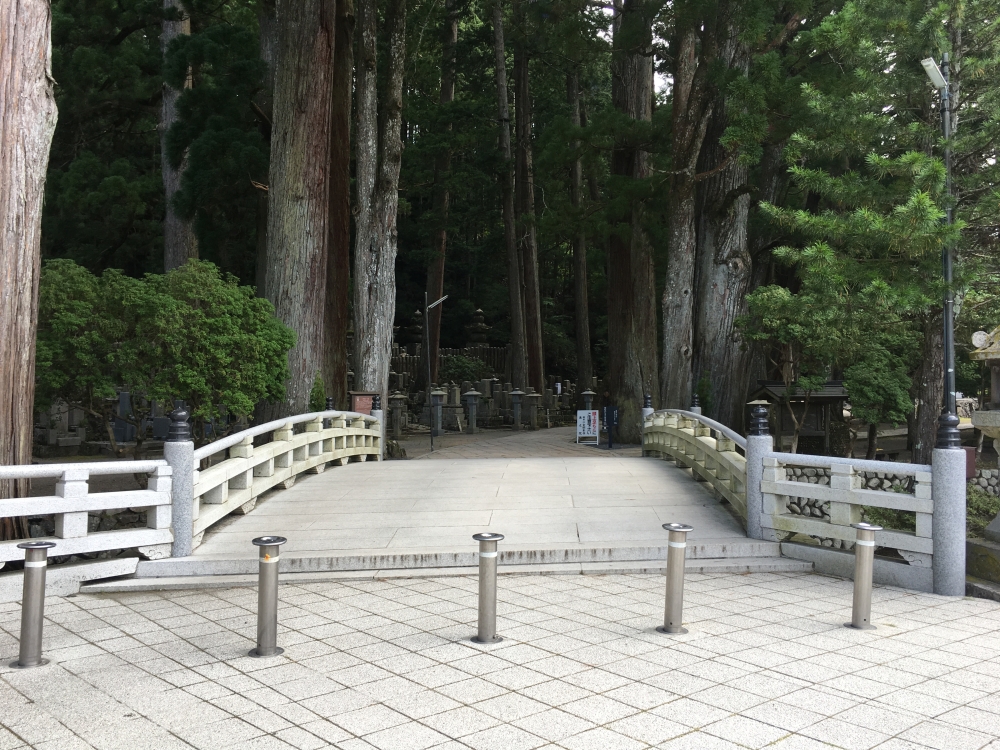
Ichinohashi bridge
I stroll through the mystical Okunoin for an hour and a half, mesmerized by the moss-covered tombs and lanterns, the brightly bibbed Jizo statues, and the soaring cedars. Though it seems the cemetery might be cool in the shade from those cedars, they don’t help in today’s heat, nearly 95F degrees and oppressively humid.
I keep following the paved pathway through Okunoin, mindful of the history and holiness here.

path in Okunoin

Jizo at Okunoin
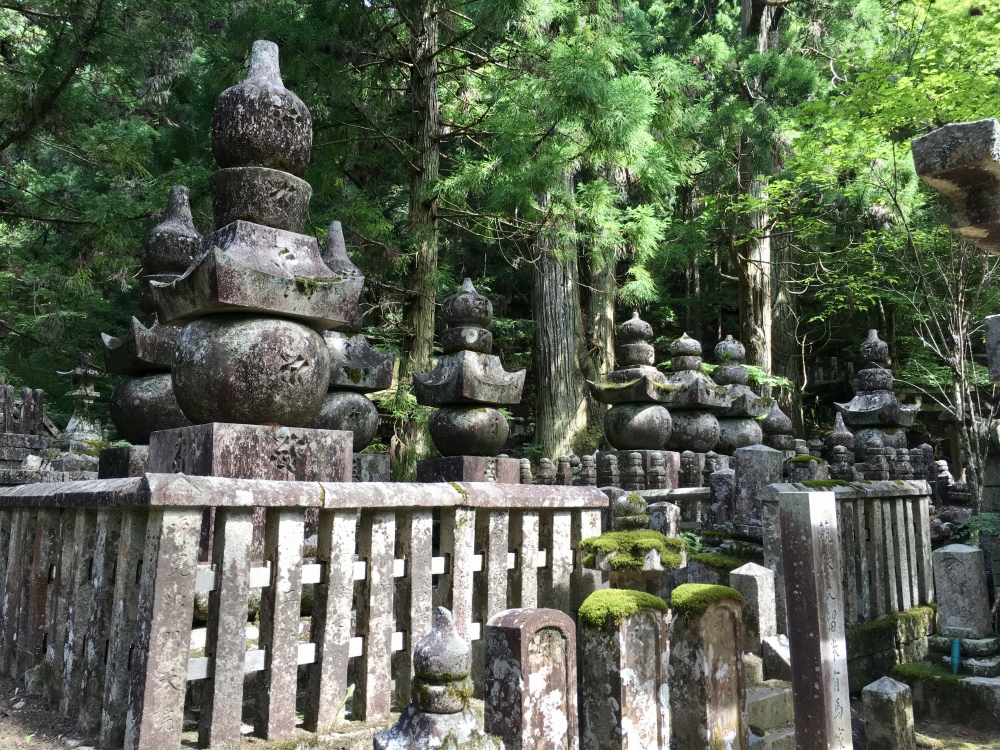
Okunoin
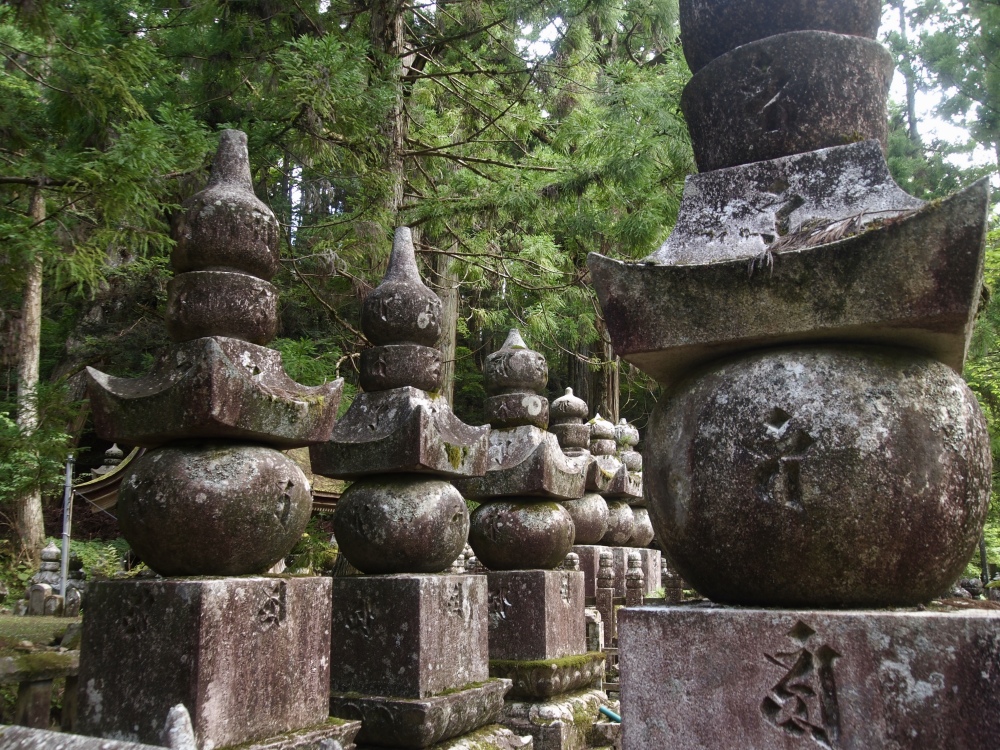
Okunoin

Okunoin

Okunoin
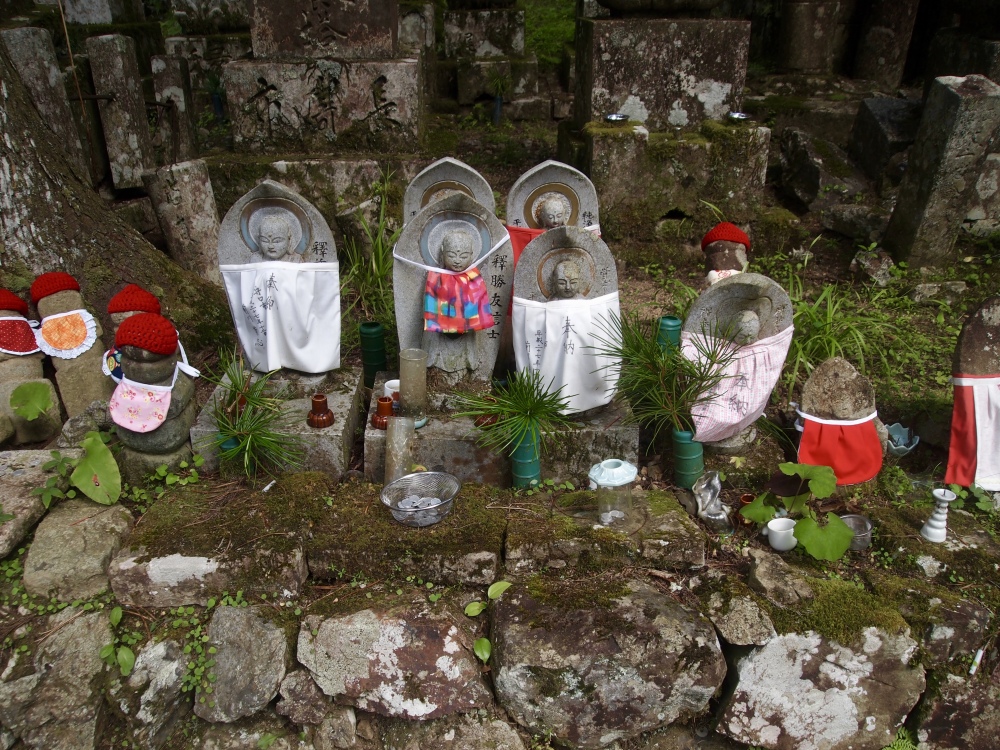
Jizo at Okunoin
Okunoin is overwhelming in its majesty and its serenity. Luckily, I got here early enough that the crowds are somewhat thin this morning.

Okunoin

Okunoin

cedar trees at Okunoin

Jizo in a tree trunk

Okunoin

soaring cedars
I come upon the Graves of Takeda Shingen and Takeda Katsuyori. On the left is a memorial to Takeda Shingen (1521-1573), an important feudal lord, and on the right is that of his son, Katsuyori (1546-1582). Both monuments have the dates of their deaths on the back.

Graves of Takeda Shingen and Takeda Katsuyori
Okunoin seems to go on and on to eternity.

pathway through Okunoin

Okunoin
The black stone statue of Asekaki Jizo (Sweating Jizo), is believed to be always perspiring since it deliberately suffers all sorts of pains on behalf of people because of their wrongdoings. I can’t see the Jizo statue, hidden as it is inside this pavilion. The Mirror Well, also not pictured because I can’t find it, is supposedly adjacent to this statue. According to legend, anyone whose reflection does not appear on the well water is destined to die within three years. Maybe it’s a good thing I don’t find it.

Asekaki Jizo (Sweating Jizo)

Jizo figure at Okunoin

tangled roots of cedars
One of the two pictures below (I’m not sure which) is the Memorial for both Friend and Foe During the Invasion of Korea. This memorial stone was erected to pray for the repose of those killed on both sides during the sixteenth-century Japanese invasion of Korea (1592-1598). It was ordered by Toyotomi Hideyoshi (1537-1598), and built by Shimazu Yoshihiro (1535-1619) and his son Tadatsune (1576-1638) in 1599. The memorial stands within the grave area of the Shimazu family, the lords of Satsuma.

Invasion for both Friend and Foe During the Invasion of Korea

Invasion for both Friend and Foe During the Invasion of Korea
There are both jolly and imposing figures in Okunoin, but I can’t begin to know the significance of them all.
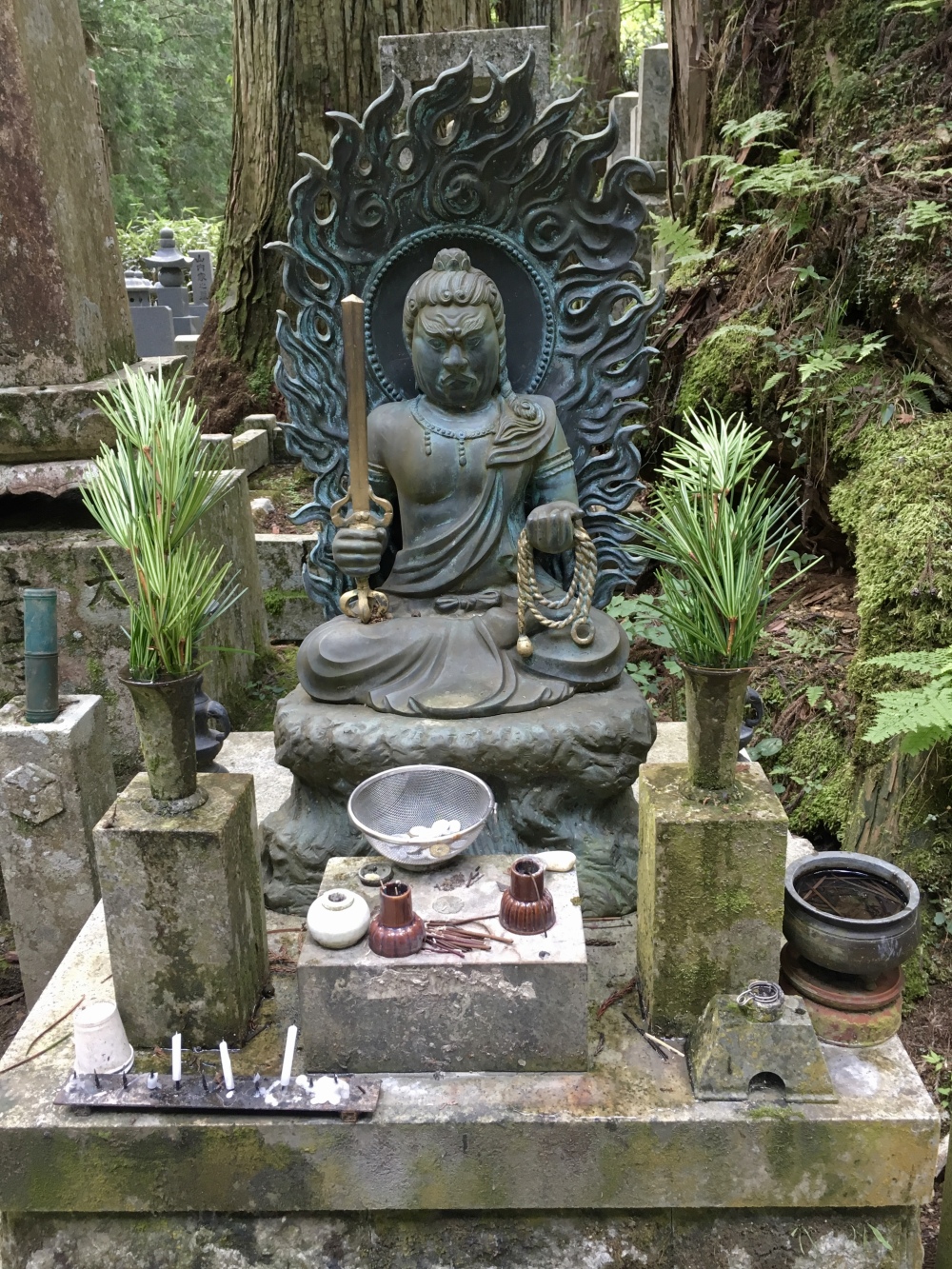
Okunoin
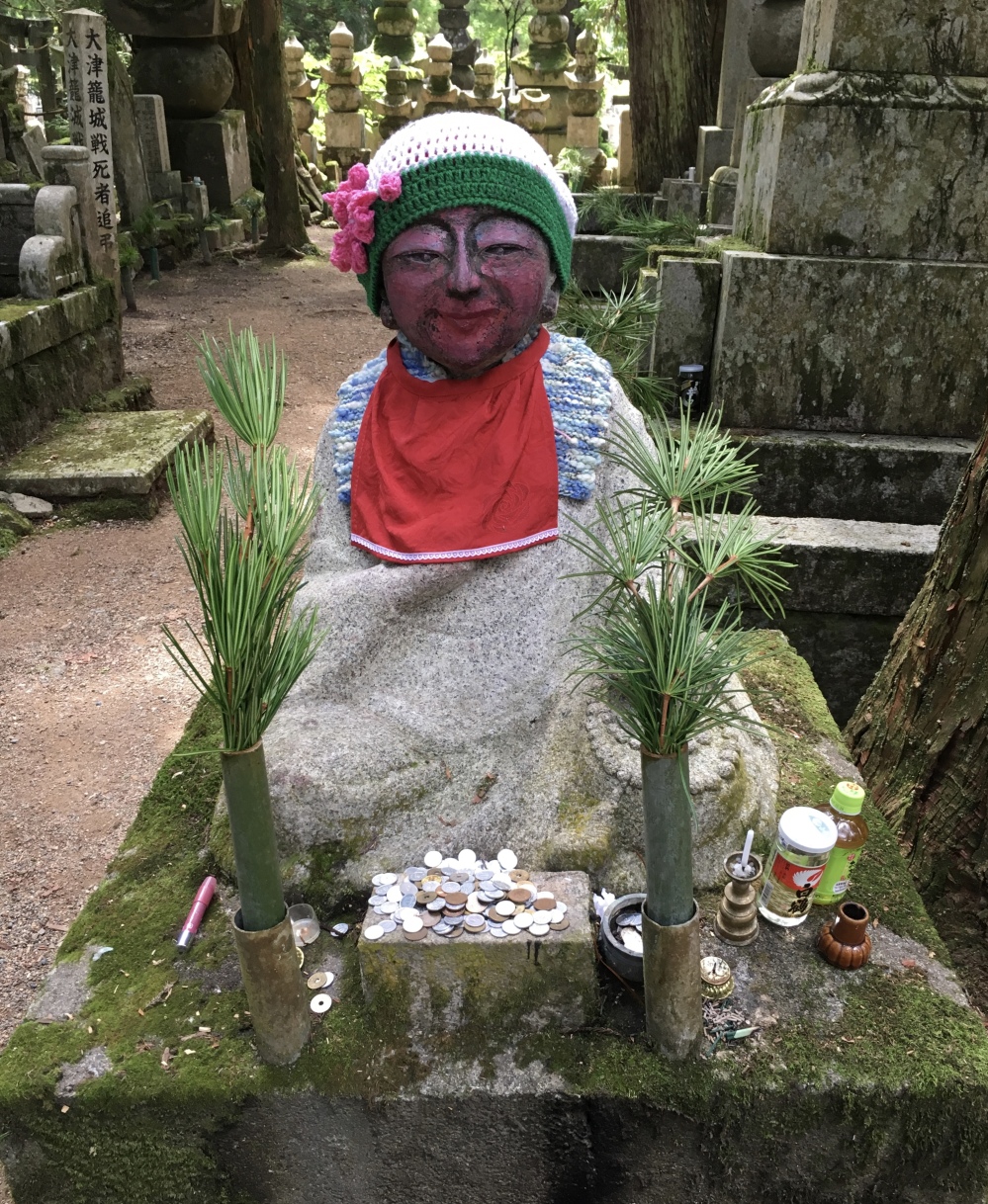
Okunoin

Okunoin

Okunoin

Okunoin
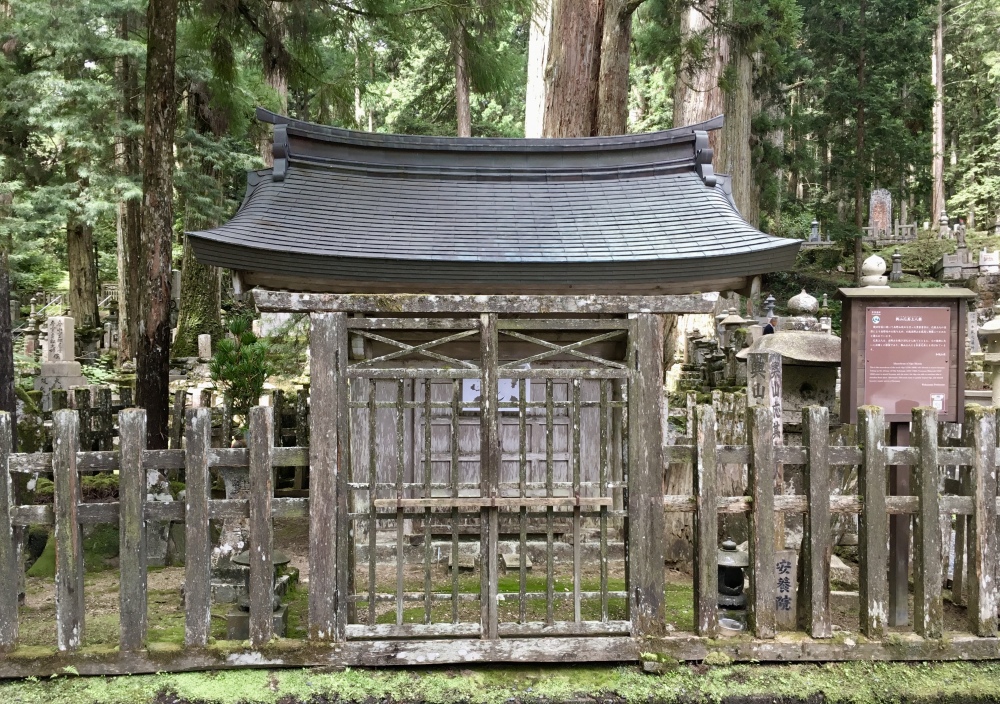
Okunoin
Gokusho Offering Hall lies near a row of statues depicting Jizo, a popular Bodhisattva that looks after children, travelers, and the souls of the deceased.
Visitors make offerings and throw water at the statues, known as Mizumuke Jizo (Water Covered Jizo) to pray for departed family members.

washing the Buddhas
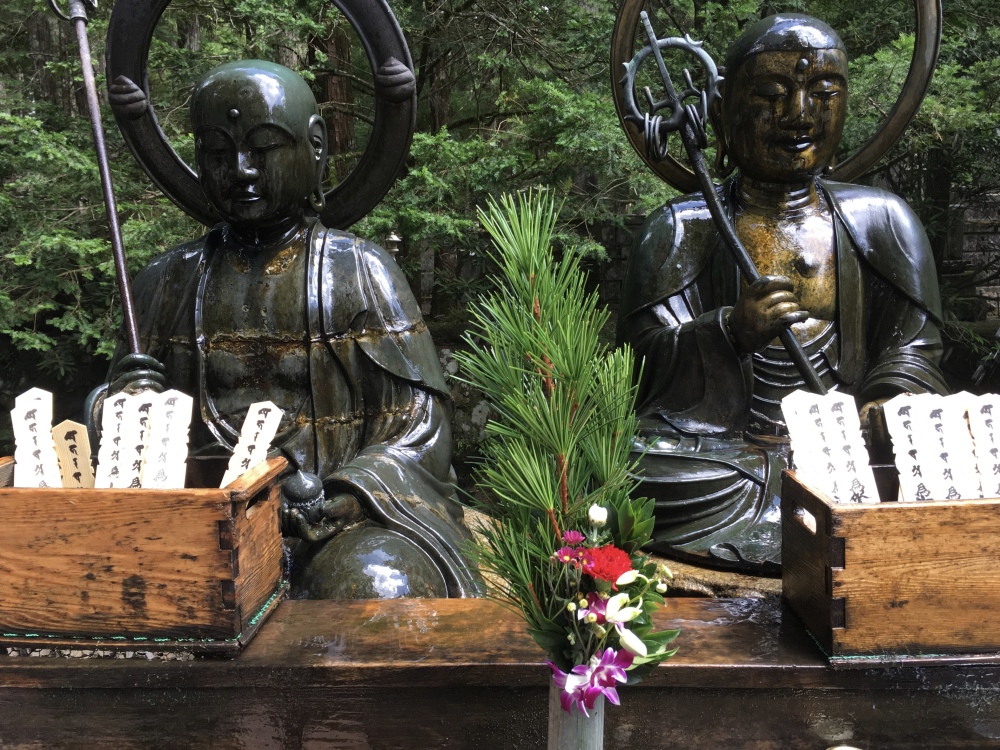
wet Buddhas

Okunoin

Busy washing of the Jizos
The Gobyo-bashi Bridge leads visitors to the mausoleum. Before crossing the bridge and entering the “sanctuary,” it is customary for visitors to groom themselves and bow deeply to Kukai, who is believed to be still alive in the mausoleum and offering prayers for all people in the world.
The bridge, originally a wooden structure, has been rebuilt in stone. The bridge has 36 stone planks, and including the bridge itself, the entire structure represents the Buddhist deities of the Diamond World Mandala. A Sanskrit letter representing each deity is carved on the underside of each plank (japan-guide.com: Okunoin Temple).
Sadly, it’s too crowded to get a photo of the bridge without people on it.

Gobyo-bashi Bridge

Gobyo-bashi Bridge
In the stream to the left of the bridge are a group of wooden markers serving as a memorial to unborn children.

in the river
No photography is allowed once we cross the bridge, but the mausoleum is quite beautiful.
Okunoin’s main hall for worship, Torodo Hall (Hall of Lamps), is built in front of Kobo Daishi’s mausoleum. Inside the hall are more than 10,000 lanterns, donated by worshipers, which are kept eternally lit. In the hall’s basement are 50,000 tiny statues donated to Okunoin in 1984, on the 1150th anniversary of Kobo Daishi’s entrance into eternal meditation.
Behind Torodo Hall is Kobo Daishi’s Mausoleum (Gobyo), the site of his eternal meditation. Visitors come from all over to pray to Kobo Daishi, and it is not uncommon to see pilgrims chanting sutras here (japan-guide.com: Okunoin Temple).
I exit the cemetery at the second entrance to Okunoin, near the Okunoin-mae bus stop. On my way out, I pass a pyramidal mound of Jizo statues.
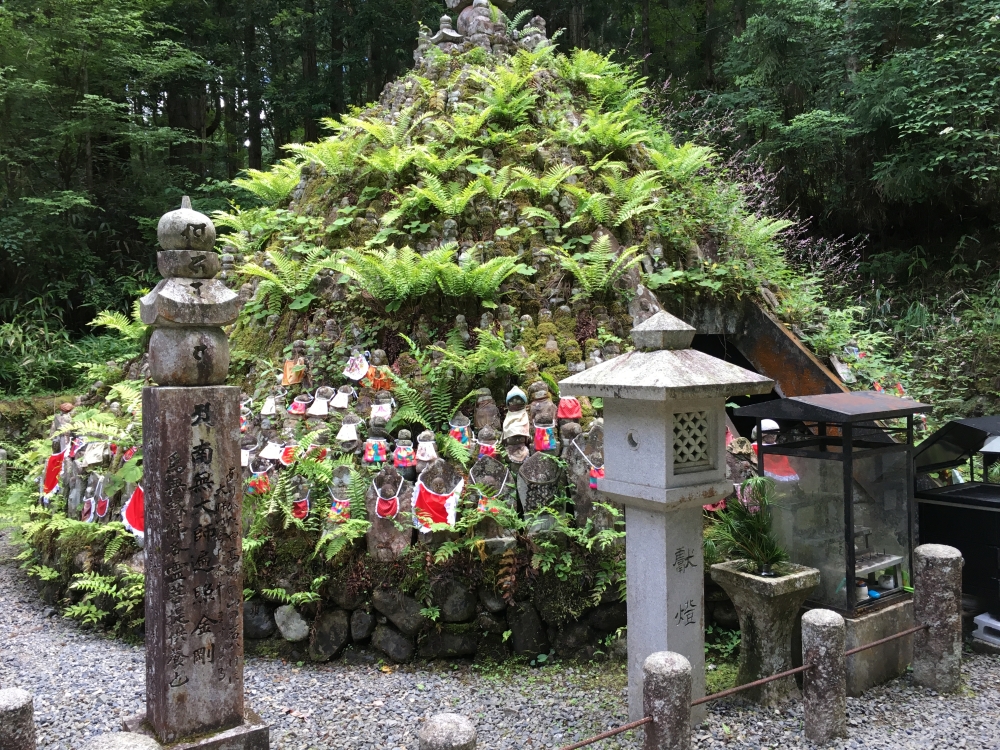
pyramid of Jizos

pyramid of Jizos

Jizo at Okunoin
It’s now about 11:00 a.m., and I stay on the bus until I reach the entrance of Kongobuji Temple, the head temple of more than 4,000 temples of the Shingon sect of Buddhism in the world.















































